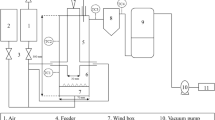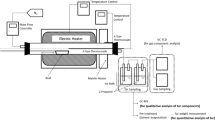Abstract
Plastic wastes have an especially high potential for use as alternative fuels, considering their high heating value and their large and stable availability. They could be used in electricity production based on gasification technologies, wherein electricity is produced in engines by means of the conversion of plastic wastes into a valuable gas. However, there are still some technical barriers to overcome before this technology can access the commercial stage, and further scientific research is needed to gain deeper understanding of the process and to be able to control and optimize it. This research presents the design and first experimental results of a bubbling fluidized bed gasifier conceived for the gasification of actual plastic residues. The experimental tests revealed that the selection and design of the reactor were adequate and proved some of the advantages of using plastic as a fuel, related in part to the absence of ashes and char. A valuable syngas over 5 MJ/m3 was generated, which contained a considerable fraction of methane as well as hydrogen and carbon monoxide as main combustible gases. The highest efficiency was achieved when the equivalence ratio was increased to 0.35, reaching 61 % in terms of cold gas efficiency and 66 % carbon conversion.








Similar content being viewed by others
Abbreviations
- BFB:
-
Bubbling fluidized bed
- Cfuel :
-
Molar flow of carbon entering the system with the fuel (mol/s)
- Cgas :
-
Molar flow of carbon exiting the system with the gas (mol/s)
- CCE:
-
Carbon conversion efficiency (%)
- CGE:
-
Cold gas efficiency (%)
- ER:
-
Equivalence ratio (–)
- Gas:
-
Gas yield (m3/kg fuel), given standard temperature and pressure (STP)
- HHVfuel :
-
Higher heating value of the input fuel (kJ/kg)
- HHVgas :
-
Higher heating value of the output gas (kJ/m3), given STP
- LDPE:
-
Low density polyethylene
References
International Energy Agency. Energy from Waste. Summary and Conclusions from the IEA Bioenergy ExCo56 Workshop (2009)
Plastics Europe. The Compelling Facts About Plastics 2007. An analysis of plastics production, demand and recovery for 2007 in Europe (Published in October 2008). Available in http://www.plasticseurope.org
Al-Salem SM, Lettieri P, Baeyens J (2009) Recycling and recovery routes of plastic solid waste (PSW): a review. Waste Manag (Oxford) 29:2625–2643
Arena U (2012) Process and technological aspects of municipal solid waste gasification. A review. Waste Manag 32:625–639
Belgiorno V, De Feo G, Della Rocca C, Napoli RMA (2003) Energy from gasification of solid wastes. Waste Manag (Oxford) 23:1–15
Ahrenfeldt J, Thomsen TP, Henriksen U, Clausen LR (2012) Biomass gasification cogeneration. A review of state of the art technology and near future perspectives. Appl Therm Eng. doi:10.1016/j.applthermaleng.2011.12.040
Wang L, Weller CL, Jones DD, Hanna MA (2008) Contemporary issues in thermal gasification of biomass and its application to electricity and fuel production. Biomass Bioenergy 32:573–581
Gómez-Barea A, Ollero P, Leckner B (2011) Optimization of char and tar conversion in fluidized bed biomass gasifiers. Fuel. doi:10.1016/j.fuel.2011.04.042
Rabou LPLM (2005) Biomass tar recycling and destruction in a CFB gasifier. Fuel 84:577–581
Vamvuka D, Zografos D, Alevizos G (2008) Control methods for mitigating biomass ash-related problems in fluidized beds. Bioresour Technol 99:3534–3544
Solimene R, Urciuolo M, Cammarota A, Chirone R, Salatino P, Damonte G, Donati C, Puglisi G (2010) Devolatilization and ash comminution of two different sewage sludges under fluidized bed combustion conditions. Exp Thermal Fluid Sci 34:387–395
Gómez-Barea A, Leckner B (2010) Modeling of biomass gasification in fluidized bed. Prog Energy Combust Sci 36:444–509
Ahmed TY, Ahmad MM, Yusup S, Inayat A, Khan Z (2012) Mathematical and computational approaches for design of biomass gasification for hydrogen production: a review. Renew Sustain Energy Rev 16:2304–2315
Gómez-Barea A, Arjona R, Ollero P (2005) Pilot-plant gasification of olive stone: a technical assessment. Energy Fuels 19:598–605
Henriksen U, Ahrenfeldta J, Jensen TK, Gøbel B, Bentzen JD, Hindsgaul C, Sørensen LH (2006) The design, construction and operation of a 75 kW two-stage gasifier. Energy 31:1542–1553
Ahmed II, Nipattummakul N, Gupta AK (2011) Characteristics of syngas from co-gasification of polyethylene and woodchips. Appl Energy 88:165–174
Environmental European Agency. Diverting waste from landfill—effectiveness of waste–management policies in the European Union. EEA Report (2009) No 7/2009
AMRA. Analysis and monitoring of environmental risks. http://www.amracenter.com/
CIUDEN Ciudad de la Energía. http://www.ciuden.es/i
Ebara Technologies. http://www.ebara.ch
McKay G (2002) Dioxin characterisation, formation and minimisation during municipal solid waste (MSW) incineration: review. Chem Eng J 86:343–368
Bircan SY, Kanamori R, Hasegawa Y, Matsumoto KOK, Kitagawa K (2011) GC-MS ultra trace analysis of dioxins produced through hydrothermal gasification of biowastes. Microchem J 99:556–560
Ménard Y, Asthana A, Patisson F, Sessiecq P, Ablitzer D (2006) Thermodynamic study of heavy metals behavior during municipal waste incineration. Process Safety Environ Protect 84 (B4):290–296
Di Blasi C (2009) Combustion and gasification rates of lignocellulosic chars. Prog Energy Combust Sci 35:121–140
Irfan MF, Usman MR, Kusakabe K (2011) Coal gasification in CO2 atmosphere and its kinetics since 1948: a brief review. Energy 36:12e40
Pinto F, Franco C, André RN, Miranda M, Gulyurtlu I, Cabrita I (2002) Cogasification study of biomass mixed with plastic wastes. Fuel 81:291–297
Aboulkas A, El harfi K, El Bouadili A (2010) Thermal degradation behaviors of polyethylene and polypropylene. Part I: pyrolysis kinetics and mechanisms. Energy Convers Manag 51:1363–1369
Aboulkas A, El harfi K, El Bouadili A (2008) Non-isothermal kinetic studies on co-processing of olive residue and polypropylene. Energy Convers Manag 49:3666–3671
Ranzi E, Dente M, Faravelli T, Bozzano G, Fabini S, Nava R, Cozzani V, Tognotti L (1997) Kinetic modeling of polyethylene and polypropylene thermal degradation. J Anal Appl Pyrol 40–41:305–319
Mastellone ML, Zacciarello L, Arena U (2010) Co-gasification of coal, plastic waste and wood in a bubbling fluidized bed reactor. Fuel 89:2991–3000
Arena U, Zaccariello L, Mastellone ML (2010) Fluidized bed gasification of waste-derived fuels. Waste Manag (Oxford) 30:1212–1219
Mastellone ML, Zaccariello L, Santoro D, Arena U (2012) The O2-enriched air gasification of coal, plastics and wood in a fluidized bed reactor. Waste Manag (Oxford) 32:733–742
Mastral FJ, Esperanza E, Berrueco C, Juste M, Ceamanos J (2003) Fluidized bed thermal degradation products of HDPE in an inert atmosphere and in air/nitrogen mixtures. J Anal Appl Pyrolysis 70:1/17
Al-Salem SM, Lettieri P (2010) Kinetic study of high density polyethylene (HDPE) pyrolysis. Chem Eng Res Des 88:1599–1606
ML De Souza-Santos (1989) Comprehensive modelling and simulation of fluidized bed boilers and gasifiers. Fuel 68:1507–1521
Acknowledgments
The work presented in this paper has been partially supported by the research project PROQUIPOL (PID-560620-2009-4) funded by the Spanish Government. We especially thank Beatriz Ferreira for her collaboration during the experimental tests.
Author information
Authors and Affiliations
Corresponding author
Rights and permissions
About this article
Cite this article
Martínez-Lera, S., Torrico, J., Pallarés, J. et al. Design and first experimental results of a bubbling fluidized bed for air gasification of plastic waste. J Mater Cycles Waste Manag 15, 370–380 (2013). https://doi.org/10.1007/s10163-013-0129-6
Received:
Accepted:
Published:
Issue Date:
DOI: https://doi.org/10.1007/s10163-013-0129-6




